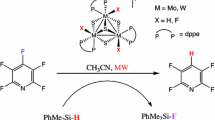Conclusions
-
1.
Molybdenum, tungsten, and uranium hexafluorides react with anhydrous acetic acid, with the formation of oxyfluorides: MoOF4, WO2F2, and UO2F2. In the presence of fluorides of the alkali metals, complex compounds of the type of KMVIO2F3 (M=Mo) and K2MVIo2F4 (M=W and U) were isolated from solution.
-
2.
Uranium hexafluoride reacts with anhydrous trifluoroacetic acid, with the formation of HUF6. In the presence of fluorides of the alkali metals, complex compounds of the type of CF3CO2MI·2UF5 (M=Li, Na, K, Rb, Cs).
-
3.
The decrease in the strength of trifluoroacetic acid in comparison with acetic acid with respect to uranium hexafluoride (CF3COOH undergoes destruction, while CH3COOH is dehydrated) is explained by the presence of a large number of fluorine atoms at the carbon atom next to the carboxyl.
Similar content being viewed by others
Literature cited
N. S. Nikolaev, Izv. Akad. Nauk SSSR, Otd. Khim. Nauk, 309 (1945).
J. W. Mellor, Comprehensive Treatise on Inorganic and Theoretical Chemistry, Vol. 11, Longmans-Green, London (1931), p. 609.
Marchetti, Z. Anorgan. Chem.,10, 66 (1895).
G. H. Dicke and A. B. F. Duncan, Spectroscopic Properties of Uranium Compounds, McGraw-Hill Book. Co., New York-Toronto (1949), p. 138.
R. L. Davidovich, Dissertation [in Russian], Moscow (1966).
A. T. Sadikova, N. S. Nikolaev, and T. A. Rasskazova, Zh. Neorgan. Khim.,15, 2012 (1970).
L. B. Asprey and R. A. Penneman, Inorgan. Chem.,3, No. 5, 727 (1964).
Yu. A. Buslaev and N. S. Nikolaev, Zh. Neorgan. Khim.,4, 205 (1959).
Yu. A. Buslaev and N. S. Nikolaev, Zh. Neorgan. Khim.,4, 465 (1959).
R. Hara and G. H. Cady, J. Amer. Chem. Soc.,76, 4285 (1954).
G. S. Fujioka and G. H. Cady, J. Amer. Chem. Soc.,79, 2451 (1957).
M. J. Baillie, D. H. Brown, K. C. Moss, and D. W. A. Sharp, J. Chem. Soc. A, 3110 (1968).
Author information
Authors and Affiliations
Additional information
Translated from Izvestiya Akademii Nauk SSSR, Seriya Khimicheskaya, No. 4, pp. 757–764, April, 1972.
Rights and permissions
About this article
Cite this article
Nikolaev, N.S., Kharitonov, Y.Y., Sadikova, A.T. et al. Reactions of molybdenum, tungsten, and uranium hexafluorides in acetic and trifluoroacetic acids. Russ Chem Bull 21, 719–724 (1972). https://doi.org/10.1007/BF00854459
Received:
Issue Date:
DOI: https://doi.org/10.1007/BF00854459




